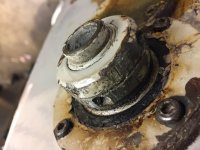SWA Guy
Aluminum
- Joined
- Aug 28, 2007
- Location
- Elk Grove, CA
I am refurbishing a horizontal/vertical manual milling machine and have hit a brick wall. In my attempt to remove the horizontal spindle I am stumped by the retaining nuts on the spindle shaft. There are no flats and only dimples “machined” into its circumference. I am at a loss as to the best method to grip these in order to remove them and later install them. Can anyone provide a little guidance? Custom vice-grip mod?
I think that I'll replace these with something else when I reassemble it, so if I need to destroy these nuts to remove them, I'm ok with that.
Here's a pic of the two nuts...

Any help would be greatly appreciated.
Guy
I think that I'll replace these with something else when I reassemble it, so if I need to destroy these nuts to remove them, I'm ok with that.
Here's a pic of the two nuts...

Any help would be greatly appreciated.
Guy

